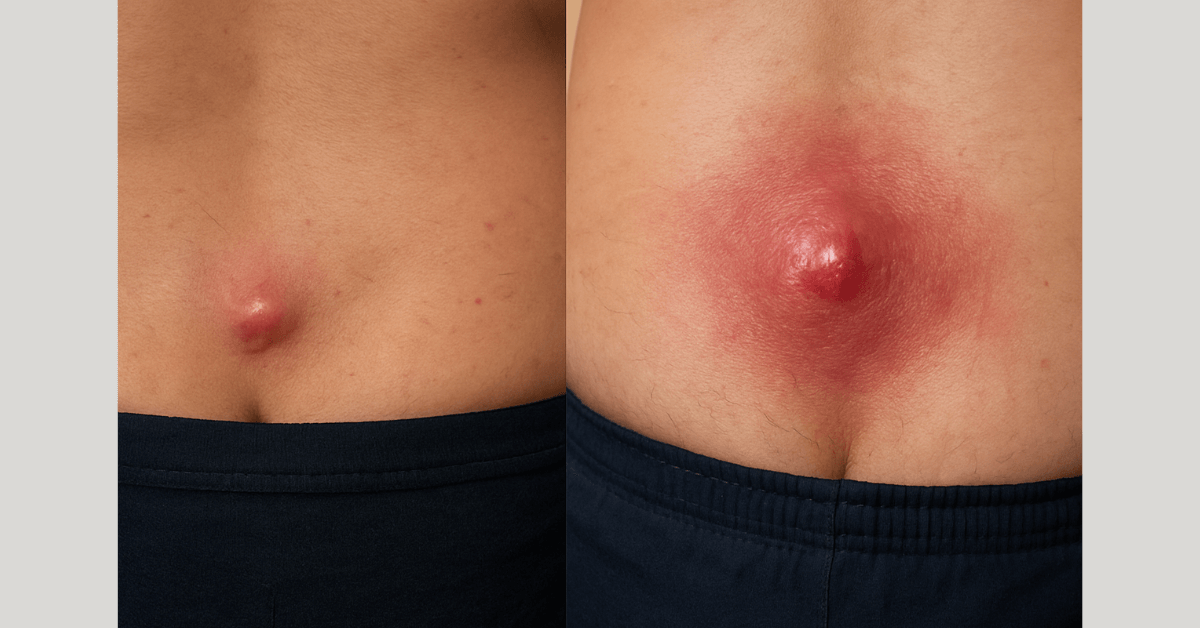Pilonidal Cyst Recurrence is a common concern for many patients who have undergone treatment for this condition. A pilonidal cyst is a small, fluid-filled sac that forms near the tailbone, often causing discomfort, swelling, and sometimes infection. Although surgical removal can provide relief, these cysts have a tendency to return if preventive measures are not followed. Fortunately, with proper care, lifestyle changes, and guidance from board-certified surgeons at IBI Clinic, the risk of recurrence can be significantly reduced.
Understanding the causes and preventive strategies is essential for anyone seeking long-term relief from pilonidal cysts. In this guide, we will explore why these cysts recur, how to prevent them, and what patients can do to maintain a healthy tailbone area after treatment.
What Is a Pilonidal Cyst?
A pilonidal cyst is a small sac that develops in the skin near the top of the crease between the buttocks. It often contains hair, skin debris, and sometimes bacteria, which can lead to infection. Men are more commonly affected than women, and the condition usually develops in young adults.
The exact cause of pilonidal cysts is not fully understood. However, several factors are believed to contribute, including ingrown hairs, prolonged sitting, friction, and poor hygiene. People with excessive body hair or those in higher-weight bodies are at higher risk. Recognizing these factors early can help prevent a recurrence after treatment.
Factors That Contribute to Pilonidal Cyst Recurrence
Even after successful treatment, pilonidal cysts can return. Therefore, understanding the factors that increase the likelihood of recurrence allows patients to take proactive steps.
Incomplete Removal
Surgical procedures that do not fully remove the cyst wall or sinus tract can leave remnants of tissue behind. These remnants can develop into a new cyst over time. Choosing a skilled surgeon, like those at IBI Clinic, can reduce this risk significantly.
Excessive Hair Growth
Hair can penetrate the skin, causing irritation and the formation of new cysts. Without proper hair management, the area remains vulnerable to recurrence.
Poor Hygiene
Failure to keep the area clean can promote bacterial growth and infection, increasing the chance of another cyst forming.
Prolonged Sitting and Pressure
Jobs or habits that involve extended periods of sitting put continuous pressure on the tailbone area, which can trigger cyst development.
Obesity and Skin Folds
Excess weight can create skin folds that trap moisture and hair, leading to a higher risk of recurrence.
By addressing these factors, patients can actively reduce the chances of pilonidal cyst recurrence.
Preventive Measures to Reduce Pilonidal Cyst Recurrence
Preventing a recurring pilonidal cyst requires a combination of hygiene practices, lifestyle adjustments, and sometimes medical interventions.
Maintain Proper Hygiene
First and foremost, keeping the area clean and dry is essential. Regularly washing the tailbone area with mild soap and water removes dirt and bacteria. After cleaning, always dry the area thoroughly. This reduces moisture, which bacteria thrive on, and lowers the risk of infection.
Remove Excess Hair
Excess hair in the tailbone area can contribute to cyst formation. Several methods can help prevent hair-related recurrence:
- Shaving: Shaving the area regularly prevents hairs from growing into the skin.
- Depilatory Creams: Gentle hair removal creams designed for sensitive skin can also be effective.
- Laser Hair Removal: For a longer-lasting solution, laser treatments reduce hair growth and the likelihood of cyst formation.
Avoid Prolonged Sitting
Sitting for long periods increases pressure and friction in the tailbone area. To reduce this risk:
- Take frequent breaks to stand and stretch, especially if your job involves desk work.
- Use cushions or ergonomic chairs to reduce direct pressure on the tailbone.
- Alternate sitting positions to avoid constant pressure on one area.
Maintain a Healthy Weight
Having a higher weight can contribute to skin folds, which may trap hair and moisture, increasing the risk of cyst formation. Following a balanced diet and exercising regularly helps maintain a healthy weight. This simple step can significantly lower the risk of a pilonidal cyst returning.
Wear Loose-Fitting Clothing
Tight clothing can rub against the skin, causing irritation and trapping sweat. Therefore, wearing breathable, loose-fitting clothes reduces friction and keeps the area dry, which helps prevent recurrence.
Use Topical Antiseptics
Additionally, applying antiseptic solutions or ointments recommended by your surgeon can reduce bacterial growth. Moreover, using these products after cleaning the area adds an extra layer of protection against infection.
Follow Post-Surgery Care Instructions
Proper care after surgery is crucial in preventing recurrence. Board-certified surgeons at IBI Clinic provide detailed instructions, which may include:
- Changing dressings regularly, which helps keep the area clean and reduce the risk of infection.
- Taking prescribed antibiotics if necessary, as this can prevent bacterial growth and complications.
- Avoiding strenuous activities until fully healed, because this allows the surgical site to recover properly.
- Attending follow-up appointments to monitor healing, so that any issues can be addressed promptly.
Adhering to these guidelines increases the likelihood of long-term success after a cyst removal procedure, while also supporting faster recovery and minimizing the chance of recurrence.
Surgical Options for Recurring Pilonidal Cysts
When conservative measures are not enough, surgical intervention may be required. Surgeons at IBI Clinic Tampa offer advanced procedures to address recurring cysts:
Excision: The cyst and surrounding tissue are completely removed. This method ensures that no residual tissue remains to cause another cyst.
Flap Surgery: In cases with a high risk of recurrence, flap surgery uses nearby tissue to close the wound. This reduces tension and prevents new cysts from forming.
SiLaC (Sinus Laser-assisted Closure): This is a minimally invasive procedure where a laser fiber is inserted into the sinus tract to destroy the infected tissue. This treatment is known for its quick recovery and minimal scarring.
Selecting the appropriate procedure depends on the patient’s condition, history of recurrence, and overall health. Surgeons provide a personalized plan to ensure the best outcome.
Lifestyle Adjustments to Support Long-Term Healing
Beyond medical care, adopting healthy habits is essential for long-term prevention:
Regular Exercise
For example, regular exercise improves circulation and supports a healthier body. Additionally, it can help maintain a balanced weight, which reduces pressure in the tailbone area.
Daily Hygiene Routine
Moreover, a daily hygiene routine, including cleaning and inspecting the area, helps detect early signs of recurrence and prevents infection.
Hair Management
In addition, consistent hair management, such as regular hair removal, remains important even after surgery to minimize irritation and reduce the chance of cyst formation.
Avoid Smoking
Avoiding smoking speeds up healing, strengthens the immune system, and lowers the risk of infection.
Together, these steps actively create a supportive environment for healing and reduce the likelihood of pilonidal cyst recurrence.
When to Consult a Specialist
If you notice pain, swelling, redness, or drainage near the tailbone, it is important to consult a healthcare provider promptly. Early treatment can prevent the cyst from worsening and reduce the need for more invasive surgery. Our providers at IBI Clinic specialize in treating complex and recurring pilonidal cysts, providing personalized care and proven surgical techniques to minimize recurrence.
Conclusion: Pilonidal Cyst Recurrence
Pilonidal Cyst Recurrence can be distressing, but understanding the risk factors and following preventive measures makes a significant difference. Maintaining hygiene, managing hair, reducing pressure, and following post-surgery care instructions are essential steps in preventing recurrence. Additionally, experienced surgeons at IBI Clinic perform every necessary procedure with precision and care, which maximizes the chances of long-term success.
Taking proactive steps today can help you avoid the pain and discomfort of a recurring cyst and support a healthier, more comfortable tailbone area for years to come.



